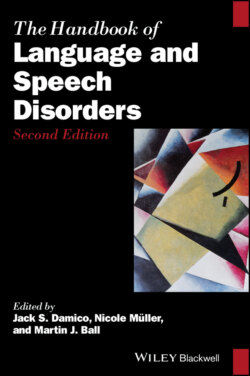Читать книгу The Handbook of Language and Speech Disorders - Группа авторов - Страница 33
2.5.2 Language and Linguistic Diversity
ОглавлениеAs just stated, language is a fundamental cultural dimension, because it is not just symbols reflecting reality, but a means to understand that reality, which concurrently influences an individual’s views of the world—a concept reiterated in linguistic relativity theory (e.g., Boroditsky, 2006). Language includes oral, written, and signed forms, and belongs to the larger framework of human multimodal communication where both linguistic (spoken/non‐spoken) and nonlinguistic (nonverbal) (e.g., kinesthetics, proxemics, chronemics) modalities are at work. Linguistic, paralinguistic, and nonlinguistic modalities are very revealing for communicative disorders in general, and especially when minority communities (e.g., deaf, indigenous, transgender) are concerned; nevertheless, like culture, these modalities may sometimes surface as secondary in clinical practice. In the background of such constructs stands context, which is what stirs the course of everything, that is, cognitive learning processes and outcomes, type(s) and ultimate attainment in language acquisition, variability in language use and usage, how all these manifest underlyingly or overtly in SLDs, and the degree to which the influence of such factors are accounted for in clinical service provision.
Sociolinguistic variation is the norm (e.g., Babatsouli, 2019a; Ball, 2005). Context, whether geographic, social, ethnic, political, cultural, disability‐related, and so forth, generates diversity in language. Linguistic diversity takes many forms, which at a primary level surfaces as language families. There are more than 7,000 languages in six macro areas in the world, a number that will double if manual language is incorporated (Ethnologue, 2019). Language diversification results from dialectal variation when dialects cease to be mutually intelligible. A difference between a language and a dialect, though, is nowadays based on political considerations: “a language is a dialect with an army and a navy” (Weinreich in Anderson, 2019). There is currently no estimation of how many dialects there are in the world, while individual languages have numerous dialects. Another type of linguistic variation is diglossia, where a single language community has access to both a low/vernacular and a high/prestigious version of their language; Standard and African American English is an example of present‐day diglossia (Babatsouli, 2019a). A theoretically based understanding of the nature of specific SLDs in bidialectal and diglossic communities are very revealing for the learning processes that pertain within such disorders.
Regional (geographic) and social (cultural) variation affects all grammatical levels in language, but pronunciation (speech), which is less prone to standardization, is affected the most (Maclagan, 2005). In speech sound disorders (SSDs), speech production outputs are indications, or decisive manifestations, used to disentangle difference from disorder, in the same way that behaviorally (thus culturally) defined criteria guide diagnosis in SLDs at large (e.g., Bowen, 2014; Norbury & Sparks, 2013). Goldstein and Horton‐Ikard (2010 and refs therein) define: “language difference (i.e., expected variations in syntax, morphology, phonology, semantics, and pragmatics) and a language disorder (i.e., a disability affecting one’s underlying ability to learn a language)” (p. 54). Different dialects carry different cultural connotations in terms of class, gender, and ethnicity, and some of them are negative and lead to social disfavor or stigma. Such “linguistic subordination” tends also to have a negative effect in clinical practice, where the presence of dialect may bring about refusal of service provision to minorities (Wolfram & Forrest, 2019) or may be misinterpreted as disorder (Battle, 2012). ASHA policies and codes clearly state that no dialect is better than another, but the issue of dialect in SLDs remains intricate in that there is still some confusion that leads to inconsistent approaches in service delivery among professionals.
On a separate level, language also varies based on both the user (in terms of identity and group membership) and the use, referring to deviations in speech style (i.e., language register), as speakers shift registers within and between different social situations. Other gradations in language variation relate to age (e.g., slang, neologisms, vs. older people’s use/idiolects), globalization effects (e.g., lingua francas), gender and sexuality, and so forth. Identification and knowledge of the many faces of linguistic diversity is paramount because, first, normative is defined based on mainstream majority usage that tends to ignore the “correctness” of minority usage, and second, processes of standardization tend to be partial as they do not account for all the facets of typical language and for ascertaining all‐encompassing norms to guide the diagnosis and remediation of impairment.
